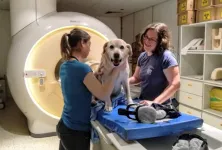(Press-News.org) The U.S. Army has awarded more than $5.7 million for two projects led by Michael Hatridge, associate professor of physics and astronomy in the Kenneth P. Dietrich School of Arts and Sciences. Both projects bring together a diverse group of researchers to overcome roadblocks in the field of quantum computing.
A four-year, $2.67 million grant is aimed at the next generation of modular quantum computing systems. Hatridge and co-principal investigators Robert Schoelkopf of Yale University have each developed unique methods to link qubits over long ranges.
With the help of Alex Jones, professor in the Swanson School of Engineering and co-principal investigator on the grant, they hope to bring these methods together, operating in tandem, to develop a new kind of quantum computing system. Jones will explore the best ways to leverage the unique properties of each method using the modular quantum computing system developed in Hatridge’s and Schoelkopf’s labs.
Once complete, the team will have developed new hardware approaches to designing superconducting quantum computers with powerful processors that bring the field a step closer to error-detected operations, or the ability to solve problems consistently and accurately.
The Army has also awarded Hatridge’s amplifier a four-year, $3.03 million grant for projects related to both the physics and the fabrication of parametric amplifiers, or “paramps,” which are necessary components of the processors that lie at the heart of quantum computing. The project’s principal investigators include David Pekker, assistant professor of physics in Pitt’s Dietrich School; José Aumentado, a physicist at the National Institute of Standards and Technology; and Hakan Türeci, an engineering professor at Princeton University.
Building paramps that satisfy the needs of these high-tech processors has been a challenge: They need large, instantaneous bandwidths and the ability to process multiple and large signals. Paramps also require must add minimal noise to amplified signals, currently Hatridge’s team’s amplifiers are within a factor of two of the ultimate limit allowed by quantum mechanics.
In the next four years, Hatridge and his team will work to better understand how the rules of physics limit paramps’ performance. The team also aims to develop and produce practical devices to move the field toward the next generation of processors.
END
Army funds two quantum-related projects at Pitt
The two grants for research led by Michael Hatridge total $5.7M
2023-05-26
ELSE PRESS RELEASES FROM THIS DATE:
Emergence of solvated dielectrons observed for the first time
2023-05-26
Solvated dielectrons are the subject of many hypotheses among scientists, but have never been directly observed. They are described as a pair of electrons that is dissolved in liquids such as water or liquid ammonia. To make space for the electrons a cavity forms in the liquid, which the two electrons occupy. An international research team around Dr. Sebastian Hartweg, initially at Synchrotron SOLEIL (France), now at the Institute of Physics at the University of Freiburg and Prof. Dr. Ruth Signorell from ETH Zurich, including scientists ...
Networks in the dog brain
2023-05-26
A study on canine brain networks reveals that during mammalian brain evolution, the role of the cingulate cortex, a bilateral structure located deep in the cerebral cortex, was partly taken over by the lateral frontal lobes, which control problem-solving, task-switching, and goal-directed behavior. The study relies on a new canine resting state fMRI brain atlas, which can aid in the analysis of diseases characterized by dysfunctional integration and communication among brain areas.
Researchers interested in how dogs think can not only deduce it from their behavior, but they can also investigate their brain activity using fMRI (functional ...
Fractons as information storage: Not yet quite tangible, but close
2023-05-26
Excitations in solids can also be represented mathematically as quasiparticles; for example, lattice vibrations that increase with temperature can be well described as phonons. Mathematically, also quasiparticles can be described that have never been observed in a material before. If such "theoretical" quasiparticles have interesting talents, then it is worth taking a closer look. Take fractons, for example.
Perfect storage of information
Fractons are fractions of spin excitations and are not allowed to possess kinetic energy. As a consequence, they are completely stationary and immobile. This makes fractons new candidates for perfectly secure information storage. Especially since ...
Defence lawyers face challenges accessing and reviewing digital evidence, study shows
2023-05-26
Defence lawyers face numerous challenges accessing and reviewing evidence from phones and computers, a new study shows.
Solicitors and barristers have reported their use of digital evidence can be restricted by limited or late access, large volumes of material, and tight turnaround times to secure legal aid funding and choose and instruct independent experts.
The research calls for more clarity and transparency around the collection and analysis of digital evidence and the streamlining of the format and presentation of information.
The current volume and diversity of digital evidence available escalates tensions, delays access to digital ...
Barren habitat for sows leaves imprint on piglets’ brains
2023-05-26
In a new study, researchers from Uppsala University in Sweden, together with colleagues from the University of São Paulo, Brazil, have investigated the impact that a barren living environment for sows leaves on the next generation. The pigs in the study were bred in Brazil and kept according to breeding standards in that country. The sows’ uncomfortable and unstimulating environment brought with it several different types of changes in the epigenome of their offspring.
In many parts of the world, sows are kept confined in concrete stalls while they are pregnant. This is a bad environment for the pigs, both in terms ...
Quantum sensor for a future navigation system tested aboard Royal Navy ship
2023-05-26
A prototype quantum sensor with potential applications in GPS-free navigation, developed at Imperial College London, has been tested in collaboration with the Royal Navy.
The test marks an important step in bringing new quantum technologies out of the lab and into real-world settings.
Many navigation systems today rely on global navigation satellite systems (GNSS), such as GPS, which uses signals from satellites orbiting the Earth. However, GPS navigation is not always accessible, obstacles like tall buildings can easily block the satellite signals, and they are also susceptible ...
Hydrogen sulfide in cancer treatment
2023-05-26
Hydrogen sulfide is usually a highly toxic gas. However, with careful preparation, it can be used to support photothermal therapy (PTT) in treating cancer, as a team of researchers reporting in the journal Angewandte Chemie has recently discovered. As the team reports, an adjuvant releasing hydrogen sulfide causes tumor cells to lose their natural heat protection and thus to become significantly more sensitive to PTT.
Breathing in gaseous hydrogen sulfide usually causes us to suffocate, because the gas suppresses the respiratory chain in the mitochondria, ...
First death in the UK associated with Xylazine
2023-05-26
The death of a 43-year-old male is the first in the UK to be associated with Xylazine and marks the entry of the drug into the UK drug supply.
New research published in the Journal of Forensic and Legal Medicine from King’s College London details the death of the man in May 2022 from the effects of Xylazine alongside heroin, fentanyl and cocaine.
Xylazine is a non-opioid sedative, painkiller and muscle relaxant used in veterinary medicine as a tranquiliser for large animals. The drug – known ...
Developing a blueprint for mobile data visualisation
2023-05-26
By Jovina Ang
SMU Office of Research – It is predicted that by 2025, almost three quarters of the internet users in the world will be mobile-only users.
While mobile devices provide ready access to data, there are limitations to how the data can be optimally presented due to the small form factor and limited screen size.
For example, it is a lot easier to show 10,000 data points on a desktop compared to a smartphone, which typically has a screen size of 2.82 inches (71.5 mm) ...
Optimising outcomes for older adults
2023-05-26
By Alistair Jones
SMU Office of Research – The contribution of team members on a research project can get taken for granted, with storied senior leaders gaining most of the attention.
A recent exception is Micah Tan, an associate researcher at the Centre for Research on Successful Ageing (ROSA) at Singapore Management University (SMU). For his collaborative work at ROSA, Tan was recognised with an inaugural 2022 Research Staff Excellence Award.
“Winning the award has given me a strong sense of fulfilment and has inspired me to want to do more, both for the SMU community but also more generally in terms of ...
LAST 30 PRESS RELEASES:
New software sheds light on cancer’s hidden genetic networks
UT Health San Antonio awarded $3 million in CPRIT grants to bolster cancer research and prevention efforts in South Texas
Third symposium spotlights global challenge of new contaminants in China’s fight against pollution
From straw to soil harmony: International team reveals how biochar supercharges carbon-smart farming
Myeloma: How AI is redrawing the map of cancer care
Manhattan E. Charurat, Ph.D., MHS invested as the Homer and Martha Gudelsky Distinguished Professor in Medicine at the University of Maryland School of Medicine
Insilico Medicine’s Pharma.AI Q4 Winter Launch Recap: Revolutionizing drug discovery with cutting-edge AI innovations, accelerating the path to pharmaceutical superintelligence
Nanoplastics have diet-dependent impacts on digestive system health
Brain neuron death occurs throughout life and increases with age, a natural human protein drug may halt neuron death in Alzheimer’s disease
SPIE and CLP announce the recipients of the 2025 Advanced Photonics Young Innovator Award
Lessons from the Caldor Fire’s Christmas Valley ‘Miracle’
Ant societies rose by trading individual protection for collective power
Research reveals how ancient viral DNA shapes early embryonic development
A molecular gatekeeper that controls protein synthesis
New ‘cloaking device’ concept to shield sensitive tech from magnetic fields
Researchers show impact of mountain building and climate change on alpine biodiversity
Study models the transition from Neanderthals to modern humans in Europe
University of Phoenix College of Doctoral Studies releases white paper on AI-driven skilling to reduce burnout and restore worker autonomy
AIs fail at the game of visual “telephone”
The levers for a sustainable food system
Potential changes in US homelessness by ending federal support for housing first programs
Vulnerability of large language models to prompt injection when providing medical advice
Researchers develop new system for high-energy-density, long-life, multi-electron transfer bromine-based flow batteries
Ending federal support for housing first programs could increase U.S. homelessness by 5% in one year, new JAMA study finds
New research uncovers molecular ‘safety switch’ shielding cancers from immune attack
Bacteria resisting viral infection can still sink carbon to ocean floor
Younger biological age may increase depression risk in older women during COVID-19
Bharat Innovates 2026 National Basecamp Showcases India’s Most Promising Deep-Tech Ventures
Here’s what determines whether your income level rises or falls
SCIE indexation achievement: Celebrate with Space: Science & Technology
[Press-News.org] Army funds two quantum-related projects at PittThe two grants for research led by Michael Hatridge total $5.7M





